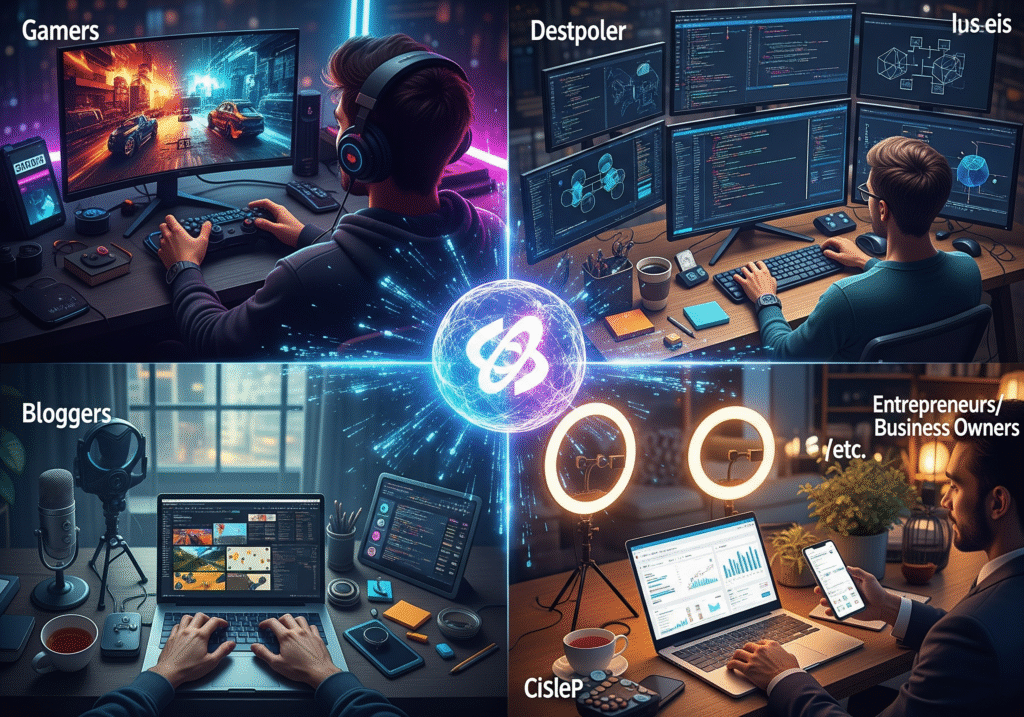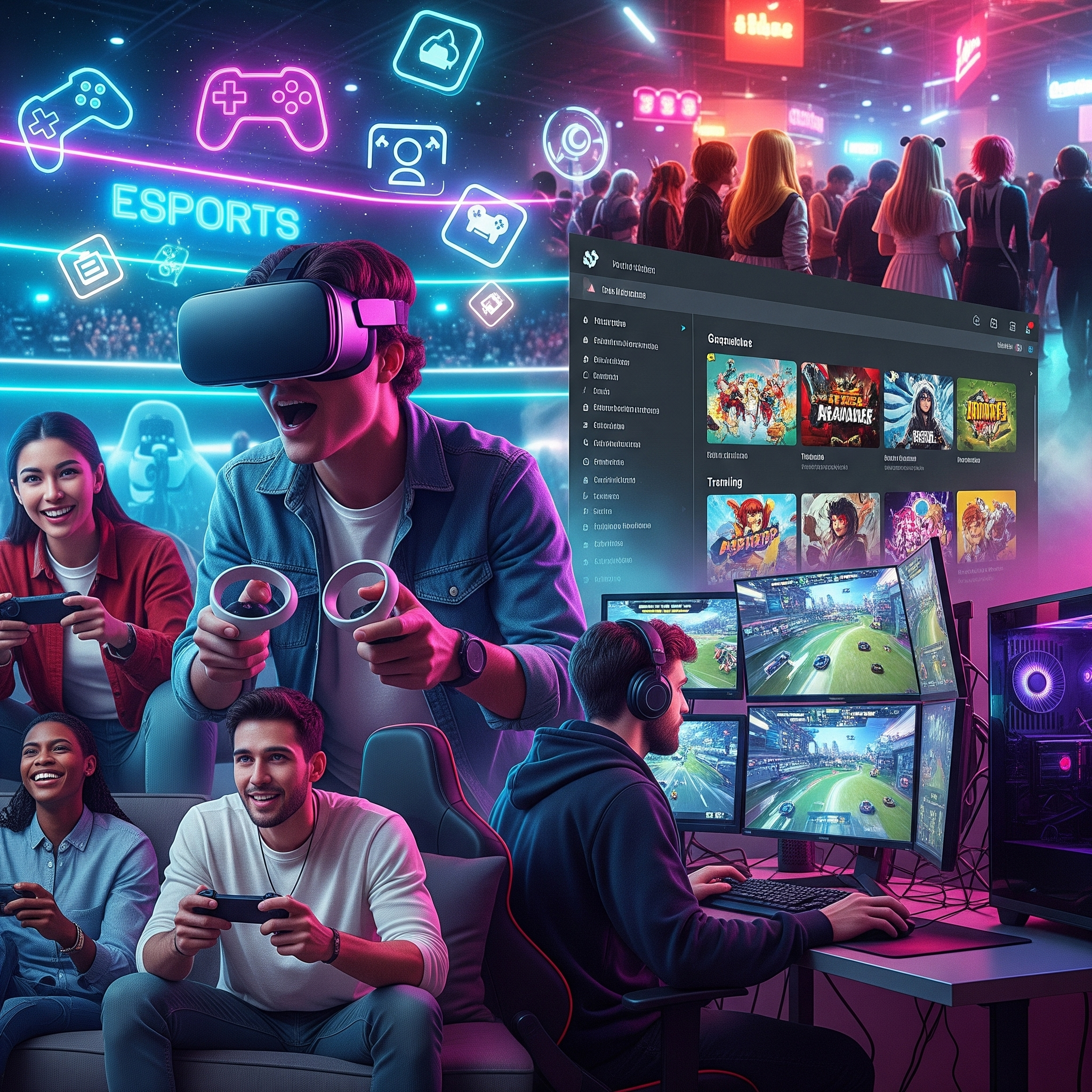Gaming isn’t just “bigger graphics” or “faster hardware” anymore. It’s changing in multiple places at once. Some of the key trends:
- AI-Driven Gameplay & Game Development
- NPCs (non-player characters) are getting smarter. They adapt, learn, respond more realistically to your actions. Not just pre-scripted responses. techspark.in+3Scope Gaming Magazine+3My Game Rank+3
- AI being used to help build games: level design, dialogue, procedural generation, balancing. That means more dynamic, personalized gaming experiences. slavnastudio.com+2Scope Gaming Magazine+2
- In esports, tools powered by AI are being used for coaching, performance analytics, opponent scouting, even fraud detection. techspark.in+2AskBonus – Best Bonuses 2025+2
- Cloud Gaming & Cross-Platform Play
- Thanks to better internet (5G, improved WiFi etc.), cloud gaming is becoming more reliable and mainstream. It’s not just a novelty; people expect to be able to play big, high-quality titles on less powerful devices via streaming. gameflig.com+2My Game Rank+2
- Cross-platform play is now a must for many gamers. PC, console, mobile — connecting them so friends can play together regardless of hardware is becoming a standard expectation. My Game Rank+2gameas.xyz+2
- VR, AR, Mixed Reality, Immersive Experiences
- Virtual Reality and Augmented Reality are moving beyond niche experimental stages and becoming more accessible. More affordable hardware, better experiences. Scope Gaming Magazine+2slavnastudio.com+2
- Mixed Reality and “persistent AR” experiences — games that overlay on real world environments, or blur the line between “real” spaces and game spaces. slavnastudio.com+2Ideal Magazine+2
- Mobile Gaming & Mobile eSports Growth
- Many regions, especially in Asia, Latin America, and Southeast Asia, are seeing mobile first or mobile dominant gaming ecosystems. Lower barriers to entry, huge user bases. Statista+3Element6+3techspark.in+3
- Mobile eSports (tournaments, competitive play) is more serious—bigger prize pools, better infrastructure. Element6+1
- Live Service Fatigue & Desire for More Curated Single-Player or Short-Form Experiences
- Many gamers are tired of “live service fatigue” — constant updates, battle passes, grinding. They want games they can finish, stories that feel complete, experiences that don’t require endless time investment. Lvl3gaming
- Indie games and mid-tier titles that are focused, polished, with clearer beginning-middle-end arcs are getting more attention and love. gameas.xyz+2Lvl3gaming+2
- Retro / Nostalgia, Cozy & Chill Gaming
- Not everything has to be ultra-intense. There is a growing taste for cozy games, relaxing games, nostalgic throwbacks. Simple, charming, social, or exploratory. Jacksonville Journal-Courier+2My Game Rank+2
- Also, remakes / reboots, retro graphics, games that harken back to older eras are resonating. My Game Rank+2thegamingmirror.blogspot.com+2
- Esports & Live Content + Betting / Sponsorship Evolutions
- Esports is continuing to scale: bigger events, bigger prize pools, more global reach. Countries like Saudi Arabia investing heavily. Reuters
- Sponsorships, streaming revenue, and viewer engagement are evolving. Betting in esports is growing, though it brings regulatory, integrity, ethical challenges. esportranker.com+2Scottmax.com+2
- Content creators / streamers remain central: people watch more than they play, sometimes. Livestreaming platforms are aggressively competing. Scottmax.com+2The Verge+2
- Accessibility, Inclusivity, and Changing Demographics
- Game developers are paying more attention to accessibility: controls, customization, options for impairments, etc. Ideal Magazine+1
- More women, older players, casual players are staying in / entering the space. “Gamers” is broadening. The Times+2Jacksonville Journal-Courier+2
- Distribution & Business Model Innovation
- Subscription and “service” models (Game Pass etc.) are more common. Pay-once games still exist, but many gamers expect multiple revenue streams behind a game (cosmetics, season passes, expansions etc.) Windows Central+2My Game Rank+2
- Alternative stores / platforms challenging big app stores in revenue splits, flexibility. Element6+1
Specific Games & Releases Making Noise
Trends are one thing; what’s bubbling under and releasing lately show what people actually are excited about.
- Assassin’s Creed: Shadows is one of the best-selling new releases in Europe in 2025, beating big names like Mario Kart World etc. GamesRadar+
- EA Sports FC 25 also having strong numbers, though with mixed reviews. GamesRadar+
- Netflix is getting more serious in gaming: launching party / co-op games for TV, expanding its gaming tab, blending streaming + gaming. The Verge
- Meta Quest 3S is being priced aggressively, bundling in good games, trying to push VR further into mainstream. Tom’s Guide
Why These Trends Are Happening (What’s Driving the Shift)
To understand trends, let’s look at what’s forcing / enabling them:
- Better infrastructure: Faster internet, more bandwidth, lower latency (5G, WiFi upgrades) make cloud gaming, streaming, mobile esports, cross-platform play more feasible.
- Hardware improvements + cost pressures: High-end hardware is expensive, so alternative ways (streaming, cloud, mobile, optimization) help lower barrier.
- Player fatigue / saturation: The live service / battlepass model has dominated for years; many gamers want something fresher.
- Demands for realism / immersion: AI, VR, AR are tools to deliver more immersive, personalized experiences.
- Changing audience expectations: Younger players expect seamless experiences, social integration, cross-device flexibility. New demographics (older players, more women) want games that are friendly, accessible.
- Monetization pressures: Game companies need to find sustainable revenue streams—subscriptions, esports, sponsorships, merchandising, microtransactions—while balancing player satisfaction.
- Streaming & content culture: The way people consume games (streams, videos) influences what kinds of games are made, what gets popular. Spectacle, shareable moments matter.
What This Really Means (for Gamers, Developers, Bloggers, etc.)

Here’s how to interpret these trends depending on your role / goal.
| If You’re a Gamer | If You’re a Game Developer / Studio | If You’re a Blogger / Content Creator |
|---|---|---|
| You’ll have more options to play big games without expensive hardware (via cloud, streaming). | You’ll need to think about cross-platform & cloud compatibility early. Don’t assume players all have high-end hardware. | There’s lots to write about: reviews, comparisons for streaming platforms, what works on mobile vs PC vs console, etc. |
| Expect games to have smarter NPCs, more emergent behavior. Some games will adapt to how you play. | Use AI tools to cut costs, speed up dev cycles, make personalization, perhaps procedural content. But also preserve quality. | Cover trends: VR/AR, AI in games, cozy / indie games, emotional storytelling. These are what people are currently curious about. |
| You may get more variety: cozy games, retro throwbacks, single-player experiences. | Think more about accessibility and inclusion from the start. Controls, UI, even narrative design need to consider broader audiences. | Be cautious with live-service fatigue: content that critiques that, or helps people choose what to invest time/money in, will get traction. |
| Watch esports / content creators live stream games — the viewing side is nearly as important as playing. | Monetization models: subscription, in-game purchases, sponsorship deals, but also new ones like blockchain, though risky. | Use insights from trending titles and genres to plan content (videos, blogs, guides). Link to what people are already searching. |
Challenges & Risks
No trend is perfect. Here are what to watch out for.
- Infrastructure variability: Cloud gaming and streaming require low latency & consistent bandwidth. In many places (especially outside US/Europe/wealthy Asia), internet sucks. Raises issues of lag, visual quality, user experience.
- AI ethics / quality issues: AI tools can generate content, but sometimes they feel generic, repetitive, or flawed. Quality control, bias, ethical issues (e.g. copying, ownership) matter.
- Monetization backlash: Players dislike being nickel-and-dimed. Battle passes, microtransactions, cosmetics, loot boxes have already earned distrust. Overreliance could alienate users.
- VR/AR hardware adoption & cost: Cheaper VR/AR is coming, but many still can’t afford it or don’t have space / comfort. Motion sickness, battery life, hardware bulk are real concerns.
- Regulation & legal issues: Esports betting, blockchain/NFT integration, data privacy are areas with regulatory uncertainty.
- Burnout & retention: With so much content and “always-on” expectations, both players and developers burn out. Live service fatigue is real.
- Fragmentation risk: If too many platforms, devices, or ecosystems exist without smooth integration, the player experience suffers (e.g. buying a game on one device and not being able to play on another, or different control schemes).
What to Keep Watching / What Might Explode Next
Here are some signals that look promising. These may be where the next big shifts happen.
- Persistent AR / Spatial Computing: If AR glasses or spatial devices become affordable and usable, games that overlay on the real world will take off. Think real-world games, location-based games, shared experiences.
- Brain-computer interfaces (BCI) or gaze-driven interfaces: Input mechanisms beyond controller / keyboard / touch. There is research and early work here. If this becomes practical, it could shift how people play and what games are possible. gameflig.com+1
- More adaptive game worlds: AI that not only responds but changes the world itself depending on what players do over time. Dynamic weather, evolving narratives etc.
- Expansion of cloud + edge computing infrastructure: As latency drops (edge servers closer, 5G/6G rollouts), cloud gaming and streaming will feel more responsive.
- Deeper integration between gaming and other media / social / events: Games becoming hubs for socializing, concerts, virtual events. Netflix games, for example. Live-event integrations.
- More ethical / sustainable monetization models: Players will reward fair value, transparency, and less exploitative monetization.
What’s Actually Trending Right Now (2025 Highlights)
To bring it home, here are what seem to be the “hot” things on people’s radars right now:
- Assassin’s Creed Shadows top among new releases in Europe. GamesRadar+
- EA Sports FC 25 is still selling strong despite critiques. GamesRadar+
- Netflix moving seriously into gaming beyond mobile — “TV party games” you play with phones etc. The Verge
- Meta Quest 3S dropping price, making VR more accessible. Bundles with strong games amplify value. Tom’s Guide
- The Xbox Game Pass catalog changes: adding big names, day-one releases, etc. Windows Central
What I’d Predict / Advice
Here are what I think will happen over the next 1-2 years based on these trends, plus some advice if you want to blog about it, develop games, or just stay ahead.
- More “hybrid” models: games that mix single-player, episodic, live service, narrative, multiplayer. You’ll see devs experimenting to find what sticks best for engagement + monetization.
- Growth of “short session” games: mobile games, or games designed for bite-sized play, but with depth. For folks who don’t have hours to commit every session.
- More tools to let players create / mod: player-generated content, mods, level editors, etc., will be more embedded in games. Community content becomes more central.
Emergence of more regional studios making globally successful games, especially from Southeast Asia, Latin America, etc. The cost of game dev tools is decreasing; distribution (digital) is global.






